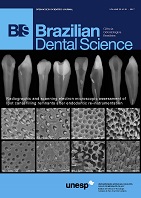Quality of bone repair in ovariectomized rats with bone lesions treated with phytotherapic and homeopathic Arnica montana
DOI:
https://doi.org/10.14295/bds.2017.v20i1.1332Abstract
Objective: National and international data show that in the next years the elder population tends to have an exponential increase becoming to be significantly higher than other ages. Among the frequent diseases in the elderly, osteoporosis is a disease that decreases bone mass and deteriorates bone structure causing fragility and a high risk of fracture. This study aimed to evaluate the effect of phytotherapic and homeopathic Arnica montana on bone repair quality and its possible use in the treatment of bone fracture in patients with osteoporosis. Material and Methods: This experimental study was performed in Wistar adult female rats divided in 4 groups according to the following treatments: ovariectomized treated with homeopathic A. montana 6CH (OVZ 6CH); ovariectomized treated with phytotherapic A. montana (OVZ TM); ovariectomized with placebo (OVZ PL) and rats with sham surgery and placebo (Sham PL). In a period of 45 days after ovariectomy or sham surgery, all animals got a monocortical lesion. They were euthanized after 6, 12, 18 and 28 days and had the tibiae removed to evaluate dimensions and bone repair by radiographic density, biomechanical test and scanning electronic microscopy (SEM). Data were analyzed by ANOVA and TUKEY tests (p < 0.05). Results: Results showed that treatment with Arnica 6CH was better than Arnica TM considering bone resistance and bone repair quality. Conclusion: This study concluded that treatment with homeopathic A. montana was more efficient than with phytotherapic Arnica in bone regeneration in rats with osteoporosis.
Keywords
Arnica montana; Homeopathy; Osteoporosis; Phytotherapy; Radiographic bone density.
Downloads
Downloads
Published
How to Cite
Issue
Section
License
Brazilian Dental Science uses the Creative Commons (CC-BY 4.0) license, thus preserving the integrity of articles in an open access environment. The journal allows the author to retain publishing rights without restrictions.
=================




























